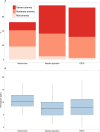Postmortem point-of care hemoglobin testing is feasible and potentially accurate among children in South Africa
- PMID: 39946440
- PMCID: PMC11824962
- DOI: 10.1371/journal.pgph.0003997
Postmortem point-of care hemoglobin testing is feasible and potentially accurate among children in South Africa
Abstract
Anemia is an important cause of child morbidity and mortality. Postmortem point-of-care hemoglobin testing is a potential method for assessing anemia at death, but its reliability has not been extensively studied. We aimed to assess the feasibility and validity of postmortem point-of-care hemoglobin assessment using HemoCue in the setting of a child mortality surveillance program in South Africa.In a pilot cohort study, 44 children under five years of age who died in an academic hospital in South Africa were enrolled. Hemoglobin levels were measured from venous blood antemortem using standard hematology analyzers and postmortem using the HemoCue 201 from blood collected within 72 hours of death (either by needle aspiration or from whole blood collected in an EDTA tube). Updated World Health Organization hemoglobin cutoffs to define anemia were used. Wilcoxon signed-rank tests, equivalence tests, and regression models assessed the concordance between antemortem and postmortem hemoglobin concentrations. Postmortem testing showed a significant decrease in hemoglobin concentrations compared to antemortem levels. However, no significant differences were found between hemoglobin measurements from needle aspiration and those from EDTA tubes postmortem. The prevalence of anemia increased from 52% antemortem to 73-77% postmortem, with the most notable rises in moderate and severe anemia. Bland-Altman analysis confirmed a systematic, not random, decrease in postmortem hemoglobin measurements. Upon applying a fixed adjustment of 2.5 g/dL, the sensitivity and specificity of postmortem hemoglobin testing to diagnose anemia were 69.6% and 61.9%, respectively. Postmortem point-of-care hemoglobin testing using HemoCue is feasible and offers a potentially valid reflection of antemortem anemia status in deceased children, despite consistently lower measured values postmortem. These findings support the utility of postmortem hemoglobin assessments in determining the presence and severity of anemia at the time of death.
Copyright: This is an open access article, free of all copyright, and may be freely reproduced, distributed, transmitted, modified, built upon, or otherwise used by anyone for any lawful purpose. The work is made available under the Creative Commons CC0 public domain dedication.
Conflict of interest statement
The authors have declared that no competing interests exist.
Figures




References
-
- United Nations. Transforming our world: the 2030 Agenda for Sustainable Development. 2015.
-
- Walker SP, Wachs TD, Gardner J, Lozoff B, Wasserman GA, et al.. Child development: risk factors for adverse outcomes in developing countries. Lancet. 2007;369(9556):145–57. - PubMed
-
- World Health Organization. Haemoglobin concentrat ions for the diagnosis of anaemia and the assessment of severity. 2011.
LinkOut - more resources
Full Text Sources
